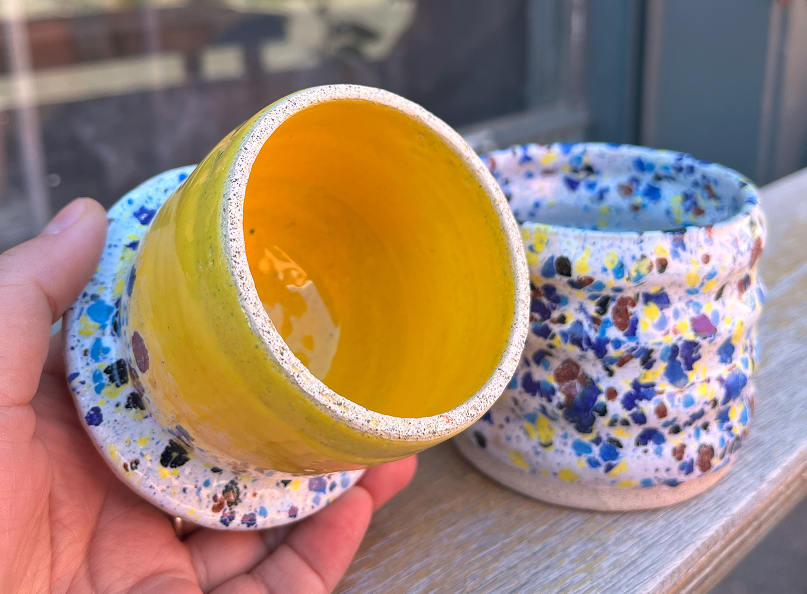What Is a Ceramic Glaze?
A ceramic glaze is a glassy coating that fuses to the surface of your pottery when fired. It serves both functional and aesthetic purposes. It makes a piece waterproof, food-safe, and adds color, texture, and personality.
Basic Composition of a Ceramic Glaze:
- Silica (glass former)
- Flux (helps it melt)
- Alumina (adds durability and thickness)
- Colorants (metal oxides or commercial stains)
When fired, the glaze melts and forms a smooth or textured surface. The magic happens in the kiln and that’s where things get beautifully unpredictable.

Application Methods: Finding What Works for You
There are several glaze application methods, and each has its strengths, quirks, and learning curve.
1. Brush-On Glaze:
These are great for beginners and a popular glazing pottery technique. You paint them onto bisqueware using a brush, usually in 2–3 coats.
Tips:
- Let each coat dry before the next.
- Stir thoroughly before use.
- Apply evenly; streaks = uneven glaze results.
2. Dipping Glaze:
Perfect for speed and coverage. You dip the whole piece into a bucket of glaze.
Tips:
- Mix thoroughly.
- Dip for 2–3 seconds max.
- Watch out for thickness and drips.
3. Powdered Glazes:
These come dry and need to be mixed with water. They’re cost-effective but need accurate mixing and sieving.
4. Spray-On Glazes:
Applied with a spray gun for smooth, even coats and layering effects. Great for large or complex forms but requires good ventilation and equipment.
Glazing Pottery: What to Watch Out For
- Thickness matters: Too thick = runs and drips. Too thin = patchy or dry texture.
- Dry between coats: Always let each coat fully dry.
- Don’t glaze the bottom: Or use stilts/kiln wash to avoid sticking.
- Test everything: Always use test tiles first.
- Glaze can behave differently depending on kiln position (top/middle/bottom), firing schedule, and clay body compatibility.
Some glazes are notorious for running, while others are more stable. Commercial ceramic glazes brands often indicate this, Botz, for example, marks glazes that tend to flow. And yes, Botz is one of my favorites: the instructions are clear, you can mix them for custom results, and Botz Plus gives magical effects.
I haven’t tried Amaco glazes yet, but I’ve heard amazing things. If you're curious, let me know on Instagram, maybe it's time I did a test run ;)
.png)
Beyond Glazes: Other Decorative Options for Pottery
So, glazes are great. But there’s a whole world of surface decoration that doesn’t melt and flow in the same way.
1. Underglazes
Underglazes are colored slips that behave more like paint. They don’t melt or move much during firing, so they’re perfect for detailed designs, lettering, and illustrations. You can apply them to greenware or bisque and then cover with a transparent glaze.
I use underglazes for paintings and fine details. They let me express more of a narrative or playful side.
.png)
2. Engobes
Engobes are colored clay slips that go on leather-hard or bisqueware. They contain more clay than underglaze and are great for textural decoration techniques like sgraffito (scratching through the surface to reveal the clay body beneath).
Engobes are part of my regular process. I often use them for sgraffito, it’s so satisfying to carve through the surface and watch the image appear.
3. Oxides and Stains
These are raw colorants you can mix into glazes or use directly (with water or frit). They offer more organic, unpredictable effects and are often used by experienced potters.
This was where I got super confused at first, what's the difference between an oxide, a stain, an underglaze? My advice: try one thing at a time.
Decorative Techniques That Use These Mediums
- Sgraffito: Scratch designs through an engobe or underglaze layer on leather-hard clay.
- Mishima: Inlay technique where lines are carved and filled with slip or underglaze.
- Layering: Combining underglaze with glazes or using multiple glazes for special effects.
- Wax Resist: Apply wax to resist glaze in certain areas for pattern or texture.
When Pottery Decoration Feels Like Too Much — Here’s What Helped Me
When I started, I felt like I had to master every technique right away. I wanted to use every glaze I saw on Instagram, try every finish, every firing method. The result? I couldn't tell what I actually liked. I was just copying and collecting.
Now, I'm taking it slow, when I can, anyway. I test, I observe, I play. And honestly, the journey feels way more rewarding this way.
Final Thoughts on Glazing Pottery for Beginners
Glazing is mesmerizing and terrifying. It’s science and magic. The result can be breathtakingly beautiful or unexpectedly disappointing, sometimes both at once. Even when you follow every rule, measure everything, and repeat your process exactly, your glaze might still surprise you.
And that’s kind of the beauty of it.
So, whether you’re brushing on your first commercial glaze, trying sgraffito with engobes, or nervously eyeing a bag of cobalt oxide, take a deep breath. Pick one thing. Play. Make test tiles. Observe. And know that no one expects you to know it all. Not even your future, wiser potter self.
We’ll cover firing in more depth in another article. For now, go get your hands dirty. Experiment. And don’t forget to share your results wins, fails, and everything in between.
Happy glazing!
—
Want to see my glaze and underglaze experiments? Follow me on Instagram @bloodypottery. I love chatting with fellow clay nerds.





.png)





.png)
.png)




